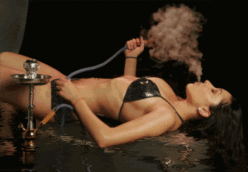A different version of the Hookah History…
Hey, these days everyone you ask has a different version of history. My fiance and I even have different memories of the same lunch. Is it hard to believe, then, that there are many different interpretations of how the Hookah became popular? I‚Äôve already mentioned other ways the hookah may have become as popular of a pipe and pastime as it is today, but here is another possible route it took from Opium Den to Grandma‚Äôs Hope Chest…
“The nargile (Hookah,huka,hooka) first became popular in the primitive form of a coconut shell in India and it is one of the oldest and most popular traditions in Turkey. There is no discrimination when it comes to smoking the hookah, as men and women equally partake and enjoy its aromatic offering. Before reaching the rest of the world, hookah popularity spread to Iran, widely recognized as the launch pad to global popularity.
Even though Iran was the final stop before global stardom, it was in Turkey where design and tradition truly took form as a cultural characteristic, and have since remained relatively unchanged.
Coffee is big in Turkey. Through this cultural mainstay, the hookah entered popular culture over 500 years ago. It soon became clear that there were certain ways to go about working the hookah, from passing the hose to lighting the coals to changing the tobacco. But don’t worry, hookah smokers are generally patient, thoughtful people who are more than willing to help you learn. Between the surreal calm and subtle customs surrounding the elaborate and often painstakingly designed hookah, its tradition soon became ingrained in Turkish culture, providing pleasure to millions.
Today, you can find hookahs in homes and restaurants around the world. In New York, there are seven lounges named after the word Nargilah! In addition to its pleasant scent and calming effects, non-smokers also find great fun in hookah smoking as the tobacco is not addictive. Moreover, cigarette smokers even replace their favorite brand for the Hookah. That is just how good it is!
We hope this short history lesson has been informative, and we know you’re curious to know more. Guess it’s time to find out for yourself.
What is shisha ?
Shisha is a mixture of tobacco and treacle, honey or sugar, and distilled water with fruit flavors. Shisha tobacco is very light and flavorful with a wonderful fruity aroma.
Shisha is not your typical tobacco. It’s nothing like the tobacco in cigars, cigarettes or dip. No, smoking true narguile shisha is an entirely different sensation. Shisha Tobacco is smoked for flavor and not for any kind of effect. It proves a relaxing and peaceful pursuit.
Shisha is very light and flavorful, with a wonderful fruity aroma. The most popular flavor is apple and others include strawberry, pineapple, apricot, grape, rose, mint and even cappuccino!
In the Middle East, from Turkey to India, there are shisha caf?ɬ©s where people gather to smoke and drink coffee or tea. Smoking shisha can last two hours or more and is a very peaceful, social occasion, generally filled with friendly conversation. A shisha smoking session can last from thirty minutes up to an hour.‚Äù
Thanks to smoking-hookah.com for their ideas on it!
